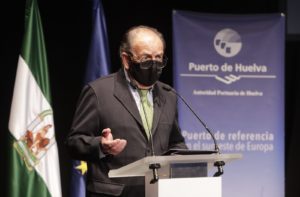
The Deputy Assistant Director of the Port Authority of Valencia participated in the conference on city-port integration organised by the Port Authority of Huelva and the Association for Collaboration between Ports and Cities (RETE)
València, May 12th, 2021.- The deputy assistant director of Valenciaport, Manuel Guerra, presented the city-port integration model at the conference organised by the Port Authority of Huelva and the Association for Collaboration between Ports and Cities RETE. Guerra gave an overview of the relationship between the port area and the city, highlighting the Special Plan project for Nazaret which will provide this neighbourhood with 230,000 square metres for green areas and sports facilities.
The conference was inaugurated by the president of the Port Authority of Huelva, Pilar Miranda, together with the president of RETE, Teófila Martínez, and the director of the Port of Huelva, Ignacio Álvarez-Ossorio, who explained the integration of the port façade of Huelva into the city.
Manuel Guerra gave a talk on “The port-city relationship. The case of Valencia” where he analysed the evolution of the link between the two entities, focusing on the most outstanding aspects of urban and port development and the port-city relationship. During his intervention, Guerra explained some of the mechanisms which Valenciaport has put in place to promote the relationship between the port and the city, where both institutions are willing to promote actions which favour the development of the other and where the citizens play a fundamental role.
The deputy assistant director of the Port Authority of Valencia (PAV) indicated that “the relationship between port and city is part of the strategy of the Spanish port system in which the port community, the regional government and the residents’ associations are involved, and is not only subscribed to the Port Authority-Town Council relationship”.
Guerra referred to the 2019 agreement on the Special Plan for South Zone 1, which will provide the Nazaret area of the city with new green, tertiary and sports spaces, with the location of the Levante UD sports city, an action that will boost the economy of the area and the urban and social regeneration of the neighbourhood. This plan is of great importance for the relationship between the city of Valencia and its port, given that it contemplates the dedication for public use of an area of 230,000 square metres of port land equivalent to more than 40 football pitches.
The deputy director of the Valenciaport also pointed out that following the agreement between the PAV and the municipal corporation in 2013, the Port of Valencia ceded 1,200,000 square metres in the northern part of the port area for public use.

